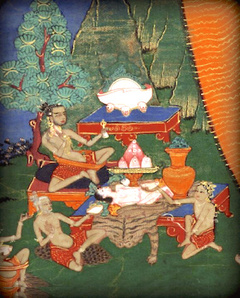Song of the Feast
༄༅། །ཚོགས་གླུ་རྡོ་རྗེའི་གསུང་བྱིན་རླབས་ཅན།
The Song of the Feast (Tsok Lu)1
by Rigdzin Jigme Lingpa
ལས་སྨོན་རྟེན་འབྲེལ་དཔག་བསམ་ལྗོན་ཤིང་གི་སྟེང་དུ། །
lemön tendrel paksam jönshing gi tengdu
Karma and aspirations coincide2 as a wish-fulfilling tree
རྒྱ་གར་ཤར་གྱི་རྨ་བྱ་གཞོན་ནུ་ཡང་ཕེབས་བྱུང༌། །
gyagar shar gyi maja zhönnu yang peb jung
Upon which the youthful peacock of eastern India alights.
རྨ་བྱའི་གདུགས་སྐོར་དམ་པའི་ཆོས་ཕྱོགས་ལ་བསྒྱུར་དང༌། །
majé duk kor dampé chö chok la gyur dang
As the peacock’s majestic tail display3 leads us to the sublime Dharma,
གཞོན་པ་ང་ཚོས་ཐར་པའི་ལམ་སྣ་ཞིག་ཟིན་ཡོང༌། །
zhönpa ngatsö tarpé lam na zhik zin yong
We, the youthful, set out on the path to liberation.
བསོད་ནམས་དཔྱིད་ཀྱི་རྒྱལ་མོའི་ཤིང་རྟ་ལ་ཕེབས་པའི། །
sönam chi kyi gyalmö shingta la pebpé
The cuckoo’s song4 from Mön’s5 southern groves
ལྷོ་མོན་ཤིང་ལོའི་ཚལ་གྱི་ཁུ་བྱུག་གི་གསུང་སྙན། །
lho mön shinglö tsal gyi khujuk gi sung nyen
Rides upon6 the chariot of merit,7 the regal spring;8
ཡ་གི་དྲི་ཟའི་བུ་མོའི་གླིང་བུ་ལས་སྙན་པ། །
yagi drizé bumö lingbu lé nyenpa
Its melody, sweeter than the flutes of the gandharva maidens above,
དབྱར་གསུམ་ནམ་ཟླ་བསྲོ་བའི་རྟེན་འབྲེལ་ལ་ཡག་བྱུང༌། །
yar sum namda sowé tendrel la yak jung
Heralds the auspicious conditions for the three nourishing months of summer.
འདིར་འདུས་ལས་སྨོན་མཐུན་པའི་རྡོ་རྗེའི་དང་སྤུན་གྲོགས། །
dir dü lé mön tünpé dorjé dang pündrok
All you vajra brothers and sisters here, united in karma and aspiration,
ང་ཚོའི་བླ་མ་བཞུགས་པའི་ཆོས་ར་ལ་ཕེབས་དང༌། །
ngatsö lama zhukpé chö ra la peb dang
Come, join us in this Dharma gathering, over which our guru is presiding!
སྨིན་གྲོལ་བདུད་རྩི་འཐུང་བའི་དགའ་སྟོན་གྱི་ངང་ནས། །
mindrol dütsi tungwé gatön gyi ngang né
At this feast, as we partake of the ripening and freeing nectar,
ཉམས་དགའ་གླུ་རུ་ལེན་པའི་ཁྱད་ཆོས་ཤིག་ཡོད་དོ། །
nyamga lu ru lenpé khyechö shik yö do
We have good reason to sing of our joyful experience.9
བདེ་ཆེན་འཕོ་འགྱུར་མེད་པའི་བཞུགས་གྲལ་གྱི་དབུས་ནས། །
dechen pogyur mepé zhuk dral gyi ü né
Within this assembly, resting in unchanging great bliss,
ལྷ་དང་བླ་མའི་ཞལ་རས་མ་བསྒོམས་ཀྱང་མཐོང་བྱུང༌། །
lha dang lamé zhalré ma gom kyang tong jung
Even without meditating, we behold the faces of deity and guru.
མ་དང་མཁའ་འགྲོའི་སྙིང་ཏིག་འོད་གསལ་གྱི་ཐེག་པས། །
ma dang khandrö nyingtik ösal gyi tekpé
Through our practice of the vehicle of luminosity, this heart-essence of the mother and ḍākinīs,
འཇའ་ལུས་ཆོས་སྐུར་འགྲུབ་པའི་དངོས་གྲུབ་ཅིག་ཞུའོ། །
jalü chökur drubpé ngödrub chik zhu o
Grant us, we pray, the siddhi of the rainbow body, the dharmakāya!
འཇིགས་གླིང་གསུམ་འབུམ་ཏ་པར་རྣམ་ཐར་ལེགས་བྱས་ཡོངས་འདུའི་སྙེ་མ་ལས་ཁོལ་དུ་ཕྱུང་བའོ། །དགེའོ། །དགེའོ། །
Extracted from the biography known as Clustered Fruit from the Wish-Fulfilling Tree of Excellent Deeds, which appears in volume 9 (ta) of Rigdzin Jigme Lingpa's collected writings. Let it be virtuous! Virtuous!
| Samye Translations (trans. Stefan Mang; ed. Lowell Cook), 2025, with reference to earlier English versions by Thinley Norbu Rinpoche, Rigpa Translations, Erik Pema Kunsang, and Benjamin Bogin. Many thanks to Adam Pearcey and Han Kop for kindly providing suggestions and clarifications.
Tibetan Source:
kun mkhyen ʼjigs med gling pa. “mkhyen brtse'i 'od zer gyi rnam thar legs byas yongs 'du'i snye ma.” In gsung ʼbum ʼjigs med gling pa (sde dge par ma). 9 Vols. BDRC MW27300_5E9644. Gangtok, Sikkim: Pema Thinley For Dodrupchen Rinpoche, 1985, Vol 9: 210–211.
rig ‘dzin ʼjigs med gling pa. “tshogs glu rdo rje’i gsung byin rlabs can.” In nyer mkho’i cho spyod gces btus thar pa’i them skas. Kathmandu: Ka-Nying Shedrub Ling, 2018: 441-442.
English Sources:
Bogin, Benjamin. "Karma and Aspirations Converge: On Tendrel, Tsok, and Two Portraits of Jigmé Lingpa" in Holly Gayley and Andrew Quintman (ed.) Living Treasure: Buddhist and Tibetan Studies in Honor of Janet Gyatso. Somerville, MA: Wisdom Publications 2023, 177–191.
Dilgo Khyentse. “The Sun Illuminating the Wisdom of Empty Awareness”. Trans. Samye Translations, Lotsawa House. https://www.lotsawahouse.org/tibetan-masters/dilgo-khyentse/tsok-lu-commentary
Kunsang, Erik Pema. “Feast Song by Kunkhyen Jigmey Lingpa.” In Dzogchen Essentials, edited by Marcia Binder Schmidt. Boudhanath: Rangjung Yeshe Publications, 2004: 249–250.
Thinley Norbu Rinpoche. Lay Mön Ten Drel by Rigdzin Jigmé Lingpa. Watsonville, CA: Bero Jeydren Publications, n.d.
Version: 2.2-20250829
- ↑ The original song, found in Rigdzin Jigme Lingpa’s autobiography, appears without a title and is therefore referred to simply by its opening syllables, Lémön Tendrel. In later editions, however, a Tibetan line describing the song as “blessed vajra speech” is sometimes added as its title. This convention is reflected, for example, in the prayer collection of Ka-Nying Shedrub Ling Monastery.
- ↑ Literally “auspicious conditions” (rten ’brel). That is: Karma and aspirations create the auspicious for a wish-fulfilling tree.
- ↑ On an outer level, the physical marvel brought forth by the gathered offerings and practitioners is symbolized by the peacock’s display (Bogin 2023, 180).
- ↑ On an outer level, the beauty of the practitioners’ chants, melodies, and music is likened to the song of the cuckoo (Bogin 2023, 180).
- ↑ Lhomön (lho mon) or Mönyül (mon yul) are early Tibetan names for a region that includes most of modern Bhutan as well as parts of Arunachal Pradesh, India and southern Tibet.
- ↑ A common variation of the verse, as reflected in Dilgo Khyentse’s commentary, reads phebs dang instead of phebs pa'i. Accordingly, the line may be rendered as: “Ride upon the chariot of merit, the regal Spring!”
- ↑ With regard to the analogy drawn here, this song is therefore a Tsok Lu—a feast song (tshogs glu)—rather than an ordinary song. The Tibetan term tsok denotes the accumulation of merit (bsod nams); hence, it is ‘a song that rides upon the accumulation of merit.’
- ↑ On an outer level, the arrival of spring signals the imminent three-month summer retreat (dbyar gnas), heralded by the cuckoo’s return from the south to Tibet and its call (Bogin 2023, 180).
- ↑ While the line literally states that vajra songs are a hallmark or distinctive feature (khyad chos) of the Vajrayāna path, it is rendered here as “we have good reason to” in order to highlight its connection to the preceding line.
